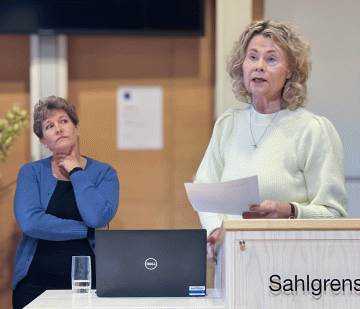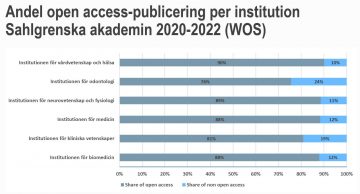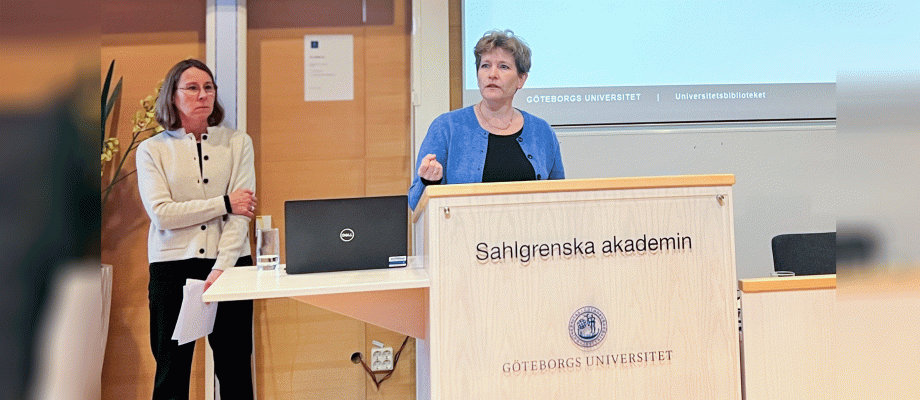GENERAL ACADEMY MEETING. The issue of increased costs in scientific publishing is complex, but future developments could potentially lead to lower expenses and increased accessibility in publishing. The General Academy Meeting on December 11 provided an interesting discussion, also addressing the challenges posed by predatory journals.
For a considerable period, the costs of scientific publishing have risen significantly each year, noted Dean Agneta Holmäng as she introduced the meeting.

“There is currently an ongoing a shift in how science is published, moving from subscription costs to publishing costs. This should eventually result in lower costs for universities and a higher proportion of openly accessible publications,” Agneta Holmäng stated during her brief opening speech.

To provide background and contribute to the discussion, the faculty management invited several experts from the University Library: Head Librarian Morgan Palmqvist, Digital Services Manager Camilla Gillén, and Team Leader for E-resources and Search Systems Rebecka Gustafsson.
Digitalization and new payment models
Until the 90s, universities paid a subscription fee for journals, which were then only available in print. The transition to electronic journals brought about new subscription models. The number of journals increased significantly, with publishers offering package subscriptions with multiple journals. In the early stages of this shift, researchers rarely paid publishing fees, and the rights to articles belonged to the journals. Even though the articles were based on publicly funded research, universities still had to pay subscription fees. Critics, advocating for free access to these articles for everyone, were numerous.
As a result of various national and international directives, the publishing landscape began to shift more clearly towards Open Access. The demand for Open Access also comes from research funders. However, open access and open publishing do not mean that articles are free. Researchers pay to retain rights to their articles by paying a fee called APC (article processing charge). This is most expensive for the most prestigious journals, where researchers also prefer to publish their results.

“This is a challenging equation. As long as the merit system functions as it does, with publications in top-ranked journals leading to high citation rates and having high merit value, we are dependent on these publishers,” said Head Librarian Morgan Palmqvist.
National agreements
Since the mid-1990s, licensing agreements with electronic journals and databases have been largely managed at the national level through the Bibsam Consortium, a division of the Royal Library. Nearly a hundred institutions and other organizations participate. Bibsam has a steering group that makes strategic decisions about negotiations. Last year, Bibsam had 49 agreements, with a turnover of 550 million SEK.
In recent years, Bibsam has started applying a new form of contract with scientific publishers: so-called transformative agreements. These agreements have parts for reading and parts for publishing, aiming to gain better control over costs and increased transparency regarding prices. The publishing cost is already included in the agreement, and the article is automatically published as Open Access. The idea behind these agreements is to push for a transition of scientific journals from subscription-based business models to a model based on Open Access.
“Calculations show that GU as a whole has benefited from these transformative agreements compared to if researchers had paid APC outside the agreement,” Rebecka Gustafsson explained during the presentation.
Improved agreement with Elsevier

The experts from the university library also brought some positive news. Starting next year, a new agreement with Elsevier will be in effect, reducing the total cost by 11 percent. For GU, this agreement will result in a 14 percent reduction in costs. Several research funders (Forte, Formas, the Swedish Research Council, and Vinnova) will also start paying for national agreements for fully open proposals, such as PLOS, eLife, and Medical Journals Sweden.
Publishing through Open Access is here to stay. The final report from SUHF’s working group “Beyond Transformative Agreements” recommends, among other things, that Bibsam should only sign agreements for journals that are fully openly accessible by 2026. In the USA, a similar development is taking place, where all federally funded research is required to be published Open Access by the end of 2025.
Connection to predatory journals
The presentation on the developments in Open Access and publishing costs sparked many thoughts. One possibility mentioned was to let research groups partially cover their own publishing costs, but experiments with this at KI indicate that it creates unnecessary administration. At KI, the trial with this solution will be discontinued. The agreements are based on a calculation of previous years’ publications, and individual researchers’ incentives would likely not significantly influence pricing.
Lena Carlsson Ekander, Vice Dean for Research, expressed that this is a question shared by all Nordic countries and that the issue of publishing costs and agreements with major publishers could ideally be coordinated with our neighboring countries.
“It’s a good point and something we should consider. We have a lively discussion about Bibsam in our library board. GU is a large university that can be a clear driver in the Bibsam Consortium,” responded Morgan Palmqvist.

Martin Lagging, Vice Dean for Research Education, raised a related question about publishing costs: so-called predatory journals that see an opportunity to make money on APC, but where peer review does not function, and the journal, therefore, lacks sufficient scientific quality. He requested a list of the 49 agreements that Bibsam has, as a kind of quality stamp indicating that journals within these publishers meet the standards. Thomas Carlsson, Academy-wide Study Director for doctoral education, agreed with Martin Lagging about the difficulties of determining which journals are less reputable but pointed out that whitelists can also contain publishers with questionable titles.
- The university library is well-versed in supporting researchers on publishing issues. The Biomedical Library has particular expertise in subjects related to the Sahlgrenska Academy. Feel free to contact them. https://www.ub.gu.se/sv/tjanster-och-stod/tjanster-for-forskare
- Here is a list of journals with discounts: https://search.scifree.se/gu
BY: ELIN LINDSTRÖM
[Translation made with support från ChatGPT 3.5]











